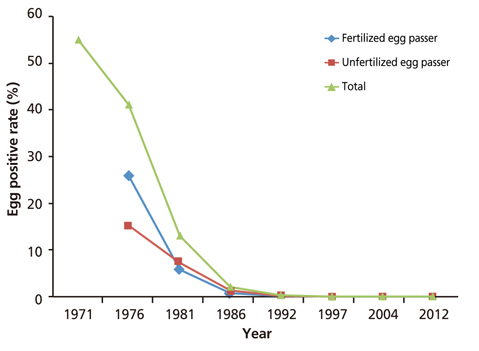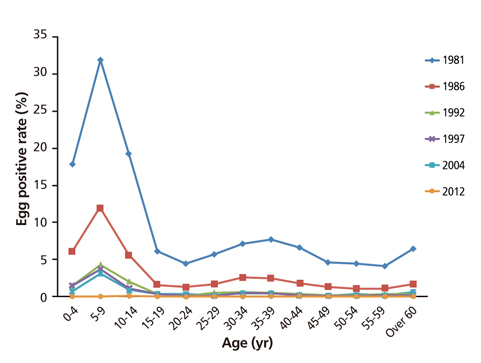J Korean Med Assoc.
2018 Mar;61(3):198-204. 10.5124/jkma.2018.61.3.198.
Is it necessary to take anthelmintics every year in Korea?
- Affiliations
-
- 1Department of Parasitology and Institute of Medical Education, College of Medicine, Hallym University, Chuncheon, Korea. shuh@hallym.ac.kr
- KMID: 2406974
- DOI: http://doi.org/10.5124/jkma.2018.61.3.198
Abstract
- Is it necessary to intake anthelmintics every year in Korea? To answer to this question, the recent nation-wide egg positive rate of the intestinal nematodes in Korea was presented. The anthelminthics which are purchasable without physician's prescription were also introduced with their pharmacological reaction and indication. The egg positive rate of Ascaris lumbricoides in 2012 was 0.025%. Those of Trichuris trichiura and Enterobius vermicularis were 0.27% and 0.004%, respectively. In 2018, purchasable anthelmintics without physician's prescription in Korea were albendazole and flubendazole only. Those two anthelmintics were derivatives of benzimidazole that may cause some side effects such as hepatitis, increase of hepatic enzymes, granulocytopenia, or pancytopenia. These anthelmintics showed excellent effect to ascariasis; while, they are not sufficient to treat trichuriaiss. For treatment of enterobiasis, repeated taking 3 times with 3 weeks interval and mass treatment of the family of egg positive person are required. In conclusion, it is not necessary to take anthelmintics every year without specific diagnosis because of negligible egg positive rate of intestinal nematodes and complicated therapeutic module for enterobiasis. There was no specific symptom of ascariasis or trchuriasis if worm burden is not high. The common symptoms of enterobiasis were pain or itching at the perianal area, sleep difficulty, or diarrhea. If intestinal nematode infection is suspected, stool examination or perianal swab should be done before prescribing anthelmintics.
MeSH Terms
Figure
Cited by 2 articles
-
Drug Induced Liver Injury by Prophylactic Administration of Albendazole
Sang Yi Moon, Yang Hyun Baek, Sung Wook Lee
Korean J Gastroenterol. 2019;73(6):360-364. doi: 10.4166/kjg.2019.73.6.360.Status of common parasitic diseases in Korea in 2019
Sun Huh
J Korean Med Assoc. 2019;62(8):437-456. doi: 10.5124/jkma.2019.62.8.437.
Reference
-
1. Yonhap News. Tens of parasites from intestine of North Korean soldier defected to the South. Hankyoreh;2017. 11. 15. cited 2018 Feb 16. Available from: http://www.hani.co.kr/arti/politics/defense/819223.html.2. Noh M, Lee Y, Oh S, Chu C, Gwack J, Youn SK, Cho SH, Lee WJ, Huh S. Spatial and temporal distribution of plasmodium vivax malaria in Korea estimated with a hierarchical generalized linear model. Osong Public Health Res Perspect. 2012; 3:192–198.
Article3. Seo BS, Rim HJ, Loh IK, Lee SH, Cho SY, Park SC, Bae JW, Kim JH, Lee JS, Koo BY, Kim KS. Study on the status of helminthic infections in Koreans. Korean J Parasitol. 1969; 7:53–70.
Article4. Jung J, Park Y, Kim OJ. A social history of ascariasis in the 1960s Korea: from a norm to a shameful disease. Korean J Med Hist. 2016; 25:167–203.
Article5. Korea Centers for Disease Control and Prevention. National survey of intestinal parasitic infections in Korea, 8th report 2013. Public Health Wkly Rep. 2014; 7:89–94.6. Hung BK, De NV, Duyet LV, Chai JY. Prevalence of soil-transmitted helminths and molecular clarification of hookworm species in ethnic ede primary schoolchildren in Dak Lak province, southern Vietnam. Korean J Parasitol. 2016; 54:471–476.
Article7. Kim MJ, Jung BK, Cho J, Kim DG, Song H, Lee KH, Cho S, Htoon TT, Tin HH, Chai JY. Prevalence of intestinal protozoans among schoolchildren in suburban areas near Yangon, Myanmar. Korean J Parasitol. 2016; 54:345–348.
Article8. DrugBank. Albendazole [Internet]. [place unknown]: DrugBank;2018. cited 2018 Feb 16. Available from: https://www.drugbank.ca/drugs/DB00518.9. Kim MK, Park HW, Kim WJ, Park CM, Hong JY, Cho SJ, Jang MK. A case of acute drug-induced hepatotoxicity after albendazole treatment. Korean J Med. 2008; 75:564–568.10. DrugBank. Flubendazole [Internet]. [place unknown]: DrugBank;2017. cited 2018 Feb 16. Available from: https://www.drugbank.ca/drugs/DB08974.11. Min DY, Ahn MH, Kim KM. Effect of flubendazole against Ascaris lumbricoides, Trichocephalus trichiurus and Enterobius vermicularis in infected children. Korean J Parasitol. 1986; 24:12–14.
Article12. Kim CD, Km JI. White sugar popular in 1960s and advertisement of anthelmintics up to 1990s. Dongailbo;2017. 12. 19. cited 2018 Feb 16. Available from: http://news.donga.com/East/MainNews/3/all/20171219/87808764/1.13. Kwak EY. Is it mandatory to take anthelmintics? Health Life News;2017. 03. 18. cited 2018 Feb 16. Available from: http://news.healthi.kr/news_view.asp?ArticleID=170317106442&catr=1601.
- Full Text Links
- Actions
-
Cited
- CITED
-
- Close
- Share
- Similar articles
-
- Anthelmintics as Potential Anti-Cancer Drugs?
- Recent Advances in the Use of Anthelmintics for Treating Nematode Infections
- Heterotopic Paragonimiasis Presented by Intra-abdominal Masses
- The Antitumor Potentials of Benzimidazole Anthelmintics as Repurposing Drugs
- Daughter cysts in a cyst of the liver: hepatic echinococcosis





